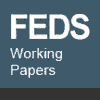
| Finance and Economics Discussion Series |
|---|
 |
Gestation Lags for Capital, Cash Flows, and Tobins's Q Jonathan N. Millar 2005-24 |
Abstract: Investment models typically assume that capital becomes productive almost immediately after
purchase and that there is no lead time needed to plan. In the case, marginal q is usually
sufficient for investment. This paper develops a model of aggregate investment where competitive
firms face no adjustment costs other than building and planning delays. In this context, both
Tobin's Q and cash flow can be noisy indicators of investment because some shocks fail to outlast
the combined gestation lag. The paper demonstrates some empirical facts that challenge prevailing
theories of investment but are consistent with gestation requirements. Regressions using aggregate
data suggest that it takes at least four quarters for investment to respond to technology shocks
and as many as eight additional quarters before productive capacity is affected. Estimates from
structural VARs show that only permanent shocks affect investment, but that cash flow and Q react
to both permanent and transitory shocks.
Home | FEDS | List of 2005 FEDS papers
Accessibility
To comment on this site, please fill out our feedback form.
Last update: May 18, 2005